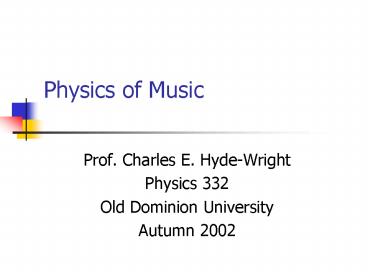Physics of Music - PowerPoint PPT Presentation
1 / 19
Title:
Physics of Music
Description:
Physics of Music. Prof. Charles E. Hyde-Wright. Physics 332. Old Dominion University ... Lab writeups due Tuesdays, 12 days after lab. Lab writeups include ... – PowerPoint PPT presentation
Number of Views:218
Avg rating:3.0/5.0
Title: Physics of Music
1
Physics of Music
- Prof. Charles E. Hyde-Wright
- Physics 332
- Old Dominion University
- Autumn 2002
2
Aesthetics in Art and Nature
- Physical mathematical attributes of music and
sound - Acoustics of Musical Instruments
- Electronic sound recording and generation
- Human sound perception
- Science does not replace aesthetics, but adds an
extra dimension
3
Why Physics?
- Physics does not claim to describe all phenomena
or experience - Physics does not explain why, but it does
elucidate how - Physics ( science) demonstrates that a
mathematical description of many phenomena is
possible, and is intellectually, technologically,
and aesthetically powerful
4
Structure of Course
- Roughly one chapter of Berg Stork / week
- Lecture on Tuesdays, Lab exercise Thursdays
- Lab writeups due Tuesdays, 12 days after lab
- Lab writeups include supplementary homework
- Research Project
- Proposal, Draft Report, Final Written and Oral
Report - Grades
- Participation 20
- Lab Assignments 25
- Project 35
- Final Exam 20
5
Phys 332 Course Topics
- Sources of sound, simple vibrations.
- Sound and waves
- Frequency analysis
- Human ear and vocal tract
- Sound Recording and Reproduction
- Room Acoustics
- Temperament, Pitch, Scales
- Wind Instruments
- String Instruments
- Piano
- Percussion
- Student Projects
6
Introduction Physics of Music
- Sound production, transmission, recording, are
physical processes. - With a microphone and oscilloscope or computer
sound card software, we can visualize sound as
an oscillation. - Sound is not a flow of air (wind, breath)
- Sound is a density and pressure wave in the air.
7
Vibrations and Waves
- Vibrations
- A mass hanging on a spring
- A microphone records the pressure oscillation at
a particular point in space
- Waves
- Water surface waves
- Vibrating string
- Light
- Sound
- Matter (Quantum)
- All waves and vibrations share common phenomena
8
Measurement and Units
- Give directions from ODU to Virginia Beach
Boardwalk - This is impossible without defining units of
distance or time, and either a coordinate system
(NS-EW) or a definition of direction.
9
Physical Quantities
- Basic
- Distance inches, miles, meters
- Time seconds, months, years
- Derived
- Frequency per second (Hz),
- Period duration of one oscillation
- Velocity meters/sec, miles/hour
- Acceleration Rate of change of velocity meters
per sec per sec
10
Period of Oscillation
11
Measurement of Oscillation
- Frequency of oscillation equals one over Period
(time to repetition). - F 1/T
- Units are cycles per sec, oscillations per sec,
or just 1/seconds Hz.
12
Soprano Recorder (880 Hz) One octave above
Concert A
13
Frequency Analysis of Soprano Recorder (A5)
14
Velocity leads position by 90 degrees of phase
15
Phase of an oscillation
- There are 360 degrees in a circle
- We can assign 360 degrees of phase to any
oscillation
16
Mass and Force units
- Force How hard you push or pull (you feel this
in your skin and bones) - Mass This is the first abstract unit, with no
purely empirical content, but without a concept
of mass it is impossible to quantify force. Mass
(or inertia) measures the resistance to change of
motion. How much force does it take to change
the motion (velocity) of an object. - 1 kg is defined as the mass of the standard
kilogram stored near Paris, France - 1 Newton is the unit of force. It is defined as
the force required to change the velocity of the
standard kilogram by 1.0 m/s in one sec.
17
Pressure and sound
- Pressure is the force per unit area.
- 1 Pascal (Pa) 1 Newton/m2
- Atmospheric pressure (105 Pa 15 lb/in2) is the
weight on each m2 of the entire column of
atmosphere above that area. - (First measured by Blaise Pascals sister)
- HW Collapse a milk jug or soda can with
atmospheric pressure.
18
Puy de Dome (France)
In 1648, Blaise Pascal directed a measurement of
the weight of air by using a barometer to measure
the pressure difference between Clermont-Ferrand
and the top of the Puy de Dome
19
Sound
- Audible sound 20 Hz 20 kHz
- Piano
- A027.5 Hz, A4440 Hz, A73520 Hz
- Threshold of hearing 2x10-5 Pa
- Threshold of painful sound 20 Pa
- Atmospheric pressure 100,000 Pa
- Weather variations (barometer) few































